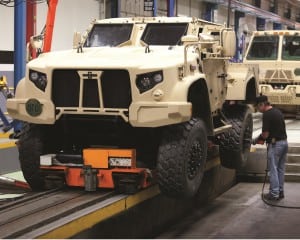The House Armed Services Committee has approved amendments to its version of the fiscal year 2021 defense authorization bill requiring the Army to assess its tactical wheeled vehicle (TWV) strategy and the acquisition approach for its RQ-7 Shadow drone replacement program.
The amendments were included as part of a package from the House Tactical Air and Land Forces Subcommittee approved unanimously during HASC’s mark-up hearing on Wednesday.

An amendment from Rep. Mike Gallagher (R-Wis.) calls for the Army to brief Congress on its plan for truncating upgrades to its TWV fleet in order to shift over towards modernization programs.
“The committee notes the Army has specifically used tactical wheeled vehicles, such as the Family of Medium Tactical Vehicles (FMTV), Joint Light Tactical Vehicle (JLTV), High Mobility Multi-Purpose Wheeled Vehicle (HMMWV), and Heavy Expanded Mobile Tactical Truck (HEMTT), as bill payers for its higher priority development and modernization programs,” Gallagher writes in his amendment. “The committee further notes that truncated plans and resources for the development or procurement of upgrades and replacements for these vehicles has resulted in uncertainty and a lack of predictability over time.”
The Army included JLTV, built by Oshkosh [OSK], in its latest round of ‘night court’ adjustments, detailing plans to further stretch out the vehicle buy and competitively award the follow-on production contract in FY ‘22 to drive down manufacturing costs (Defense Daily, Feb. 11).
The plan also calls for reducing FMTV spending to $95 million in FY ’21, down from FY ’20’s level of $138 million, as well as just $7 million for FHTV trucks in FY ’21.
“As the committee predicted two years ago, the drastic, unexpected decrease in procurement projections for these vehicle programs has negatively affected the medium and heavy tactical wheeled vehicle industrial base,” Gallagher writes in his amendment. “The committee believes the TWV industrial base needs stability and predictability from the Army in its near and longer-term plans and programs that appropriately manages risks through investment in production levels that meet or exceed agreed upon minimum sustaining rates ensuring its availability to support the Army in current operations and into the future.”
Rep. Trent Kelly (R-Miss.) also introduced an amendment for GAO to assess the Army’s plan for electrifying its tactical wheeled vehicles and integrating new technology improvements across the fleet.
For the Future Tactical UAS (FTUAS) program to replace the Army’s RQ-7 Shadow drones, Rep. Jim Banks’ (R-Ind.) amendment directs the Army to provide a briefing on the acquisition strategy and consideration for currently fielded UAS capabilities.
“The committee is pleased the Department of Army is taking steps to advance the development and procurement of next generation tactical UAS programs. However, recognizing the need to grow the domestic UAS industry and the rapid pace of technological innovation, the committee expects the Army would fully evaluate and consider all domestic UAS proven technologies already fielded under a Small Business Innovation Research grant phase 2 or 3 contract, before issuing a production award under the Army’s FTUAS program,” Banks wrote in his amendment.
The Army started its first FTUAS soldier assessment in April providing the Arcturus UAV JUMP 20 to a brigade combat team for a five-month evaluation (Defense Daily, April 9).
Evaluations with the three other competitors, Martin UAV’s V-Bat, Textron’s [TXT] AAI Corp’s Aersonde and L3Harris’ [LHX] FVR-90, will also begin the coming months.